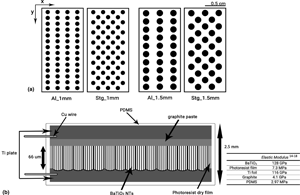Article contents
Array pattern effects on the voltage output of vertically aligned BaTiO3 nanotubular flexible piezoelectric nanogenerator
Published online by Cambridge University Press: 22 July 2020
Abstract

The advancement of lead-free piezoelectric nanogenerators (PENGs) for flexible electronics necessitates designing more efficient systems for improved energy storage capacity. In this light, the effects of patterning BaTiO3 nanotubes within PENG on the electromechanical properties of the device were investigated. The PENGs comprised a sandwich structure of Ti–BaTiO3–graphite–Ti encapsulated in polydimethylsiloxane. Four patterns of vertically aligned BaTiO3 nanotubes were synthesized via the hydrothermal conversion of selectively-anodized TiO2 nanotubes. The highest output voltage reached up to 1.9 V. Decreasing the nanotube array spacing and pattern diameter increased the lateral displacement of BaTiO3 therefore, increasing the output voltage of the device.
- Type
- Research Letters
- Information
- Copyright
- Copyright © Materials Research Society, 2020
References
- 3
- Cited by





